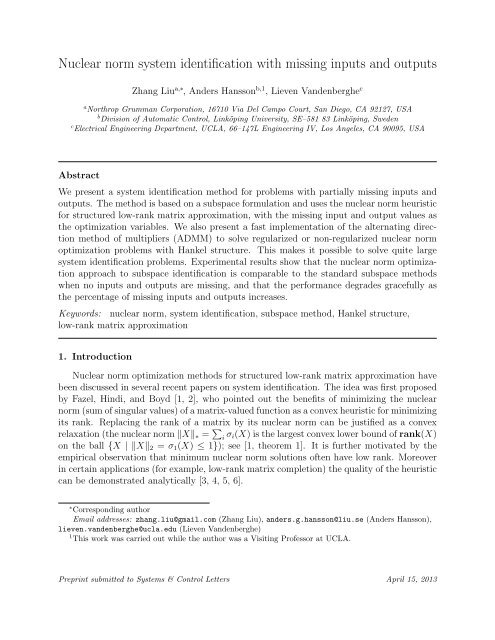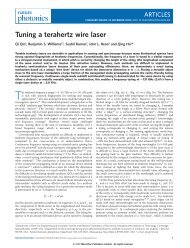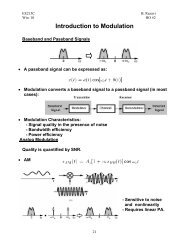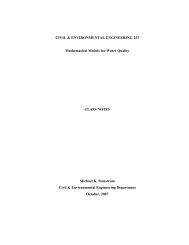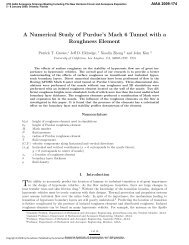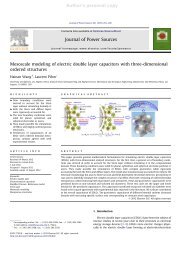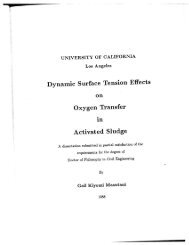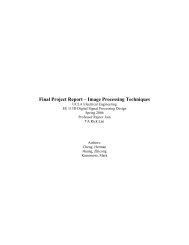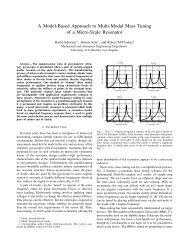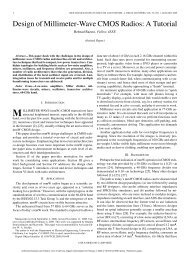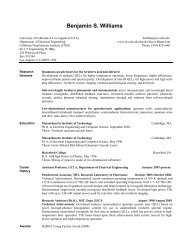Nuclear norm system identification with missing inputs and outputs
Nuclear norm system identification with missing inputs and outputs
Nuclear norm system identification with missing inputs and outputs
You also want an ePaper? Increase the reach of your titles
YUMPU automatically turns print PDFs into web optimized ePapers that Google loves.
<strong>Nuclear</strong> <strong>norm</strong> <strong>system</strong> <strong>identification</strong> <strong>with</strong> <strong>missing</strong> <strong>inputs</strong> <strong>and</strong> <strong>outputs</strong>Zhang Liu a,∗ , Anders Hansson b,1 , Lieven V<strong>and</strong>enberghe ca Northrop Grumman Corporation, 16710 Via Del Campo Court, San Diego, CA 92127, USAb Division of Automatic Control, Linköping University, SE–581 83 Linköping, Swedenc Electrical Engineering Department, UCLA, 66–147L Engineering IV, Los Angeles, CA 90095, USAAbstractWe present a <strong>system</strong> <strong>identification</strong> method for problems <strong>with</strong> partially <strong>missing</strong> <strong>inputs</strong> <strong>and</strong><strong>outputs</strong>. The method is based on a subspace formulation <strong>and</strong> uses the nuclear <strong>norm</strong> heuristicfor structured low-rank matrix approximation, <strong>with</strong> the <strong>missing</strong> input <strong>and</strong> output values asthe optimization variables. We also present a fast implementation of the alternating directionmethod of multipliers (ADMM) to solve regularized or non-regularized nuclear <strong>norm</strong>optimization problems <strong>with</strong> Hankel structure. This makes it possible to solve quite large<strong>system</strong> <strong>identification</strong> problems. Experimental results show that the nuclear <strong>norm</strong> optimizationapproach to subspace <strong>identification</strong> is comparable to the st<strong>and</strong>ard subspace methodswhen no <strong>inputs</strong> <strong>and</strong> <strong>outputs</strong> are <strong>missing</strong>, <strong>and</strong> that the performance degrades gracefully asthe percentage of <strong>missing</strong> <strong>inputs</strong> <strong>and</strong> <strong>outputs</strong> increases.Keywords: nuclear <strong>norm</strong>, <strong>system</strong> <strong>identification</strong>, subspace method, Hankel structure,low-rank matrix approximation1. Introduction<strong>Nuclear</strong> <strong>norm</strong> optimization methods for structured low-rank matrix approximation havebeen discussed in several recent papers on <strong>system</strong> <strong>identification</strong>. The idea was first proposedby Fazel, Hindi, <strong>and</strong> Boyd [1, 2], who pointed out the benefits of minimizing the nuclear<strong>norm</strong>(sumofsingularvalues)ofamatrix-valuedfunctionasaconvexheuristicforminimizingits rank. Replacing the rank of a matrix by its nuclear <strong>norm</strong> can be justified as a convexrelaxation(thenuclear<strong>norm</strong>‖X‖ ∗ = ∑ i σ i(X)isthelargestconvexlowerboundofrank(X)on the ball {X | ‖X‖ 2 = σ 1 (X) ≤ 1}); see [1, theorem 1]. It is further motivated by theempirical observation that minimum nuclear <strong>norm</strong> solutions often have low rank. Moreoverin certain applications (for example, low-rank matrix completion) the quality of the heuristiccan be demonstrated analytically [3, 4, 5, 6].∗ Corresponding authorEmail addresses: zhang.liu@gmail.com (Zhang Liu), <strong>and</strong>ers.g.hansson@liu.se (Anders Hansson),lieven.v<strong>and</strong>enberghe@ucla.edu (Lieven V<strong>and</strong>enberghe)1 This work was carried out while the author was a Visiting Professor at UCLA.Preprint submitted to Systems & Control Letters April 15, 2013
2. Subspace <strong>system</strong> <strong>identification</strong>Inthissectionwereviewthebasicideasofsubspace<strong>identification</strong>methodsforlineartimeinvariant<strong>system</strong>s [7, 8]. These methods estimate linear state-space models <strong>with</strong> process <strong>and</strong>measurement noise. Without loss of generality we can adopt the Kalman <strong>norm</strong>al formx(k +1) = Ax(k)+Bu(k)+Ke(k)y(k) = Cx(k)+Du(k)+e(k),(2)<strong>with</strong> x(k) ∈ R nx , u(k) ∈ R nm , e(k) ∈ R np , <strong>and</strong> y(k) ∈ R np [7, page 99]. It is assumed thate(k) is ergodic, zero-mean, white noise.The starting point of the derivation is the matrix equationY 0,r,N = O r X 0,1,N +S r U 0,r,N +E (3)which follows from the state-space equations (2). The matrices Y 0,r,N <strong>and</strong> U 0,r,N are blockHankel matrices constructed from the sequences y(k), u(k) for k = 0, ..., r +N −2, usingthe notation (1). The matrix X 0,1,N has as its columns the states x(k), k = 0,...,N − 1.The matrices O r <strong>and</strong> S r are defined as⎡ ⎤ ⎡⎤C D 0 0 ... 0CACB D 0 ··· 0O r =CA 2, S⎢ ⎥ r =CAB CB D ··· 0,⎢⎥⎣ . ⎦ ⎣ . . .... . ⎦CA r−1 CA r−2 B CA r−3 B CA r−4 B ... D<strong>and</strong> E contains the contribution of the noise sequence e(k) to the output. The subspacemethods discussed in this paper have in common that they first estimate the range spaceof the extended observability matrix O r <strong>and</strong> then determine a <strong>system</strong> realization from theestimate of range(O r ). (These methods therefore require that r is taken greater than n x ; thecolumn dimension N then follows from r <strong>and</strong> the length of the input <strong>and</strong> output sequences.The values of r used in our experiments will be mentioned in section 5.) Subspace algorithmsof this type are described in detail in [7, §10.6] <strong>and</strong> [8, chapter 9]. Other approaches, whichfirst estimate the matrix of states X 0,1,N (see, for example, [18]) will not be discussed here.2.1. Extended observability matrixBasic algorithm. In the simplest variant the matrix Y 0,r,N is multiplied on the right <strong>with</strong> aprojection matrix that projects on the nullspace of U 0,r,N [19]. This gives the equationY 0,r,N Π 0,r,N = O r X 0,1,N Π 0,r,N +EΠ 0,r,N , (4)where Π 0,r,N is the orthogonal projection matrix on the nullspace of U 0,r,N . Suppose thematrix X 0,1,N Π 0,r,N has full row rank, i.e., rankX 0,1,N = n x <strong>and</strong> no rank cancellation occursin the product X 0,1,N Π 0,r,N . Equivalently,[ ]X0,1,Nrank = nU x +rankU 0,r,N . (5)0,r,N3
This condition holds generically when the <strong>inputs</strong> are chosen at r<strong>and</strong>om. Under this assumptionthe first term on the right-h<strong>and</strong> side of (4) has rank n x <strong>and</strong> its range equals the rangeof O r . In the absence of noise (E = 0), one therefore hasn x = rank(Y 0,r,N Π 0,r,N ), range(O r ) = range(Y 0,r,N Π 0,r,N ).In the presence of noise (E ≠ 0), these identities hold only approximately <strong>and</strong> one can estimatenx <strong>and</strong>range(O r )fromalow-rankapproximationofY 0,r,N Π 0,r,N , obtainedbytruncatingan SVD.An efficient implementation of this scheme is the MOESP (MIMO Output-Error State-Space) algorithm [20]. In this method one first computes an LQ factorization[ ]U0,r,N=Y 0,r,N[ ][ ]L11 0 Q1L 21 L 22 Q 2of the stacked input <strong>and</strong> output Hankel matrices. The diagonal blocks L 11 <strong>and</strong> L 22 aretriangular matrices of order rn m <strong>and</strong> rn p , respectively. The matrices Q 1 <strong>and</strong> Q 2 have Ncolumns <strong>and</strong> satisfy Q 1 Q T 1 = I, Q 2 Q T 2 = I, Q 1 Q T 2 = 0. We have Π 0,r,N = I −Q T 1Q 1 <strong>and</strong>HenceY 0,r,N Π 0,r,N = (L 21 Q 1 +L 22 Q 2 )(I −Q T 1Q 1 ) = L 22 Q 2 .range(Y 0,r,N Π 0,r,N ) = range(L 22 )<strong>and</strong> the range space of O r can be estimated from an SVD of L 22 .Instrumental variables. The basic projection method described in the previous paragraphis not consistent: the range of Y 0,r,N Π 0,r,N does not necessarily converge to the range of O ras N goes to infinity. This deficiency can be resolved by the use of instrumental variables[21, 22]. We define an instrumental variable matrix[ ]U−s,s,NΦ =(7)Y −s,s,Nby combining Hankel matrices of ‘past’ <strong>inputs</strong> <strong>and</strong> <strong>outputs</strong>. (More generally, one can usedifferent row dimensions for the two Hankel matrices in Φ, but we will take them equal forsimplicity. In the experiments of section 5 we will use s = r.) Multiplying (4) on the right<strong>with</strong> Φ T givesY 0,r,N Π 0,r,N Φ T = O r X 0,1,N Π 0,r,N Φ T +EΠ 0,r,N Φ T .It can be shown that lim N→∞ (1/N)EΠ 0,r,N Φ T = 0 <strong>and</strong> that, under weak assumptions, thelimit1limN→∞ N X 0,1,NΠ 0,r,N Φ Thas full rank n x (see [8, §9.6] for a detailed discussion). As a consequence, the range ofY 0,r,N Π 0,r,N Φ T gives a consistent estimate of the range of O r . In practice, for finite N, atruncated SVD of Y 0,r,N Π 0,r,N Φ T is used to estimate range(O r ).4(6)
Asforthebasicprojectionmethod, theinstrumentalvariableschemecanbeimplementedusing an LQ factorization⎡⎣⎤ ⎡U 0,r,NΦ ⎦ = ⎣Y 0,r,N⎤L 11 0 0L 21 L 22 0 ⎦L 31 L 32 L 33⎡⎣⎤Q 1Q 2⎦ (8)Q 3of the stacked input <strong>and</strong> output Hankel matrices [8, section 9.6.1]. The diagonal blocks in Lare triangular of order rn m , s(n m +n p ), <strong>and</strong> rn p . The matrices Q i have column dimensionN <strong>and</strong> satisfy the orthogonality properties Q i Q T i = I <strong>and</strong> Q i Q T j = 0 for i ≠ j. It is readilyshown thatY 0,r,N Π 0,r,N Φ T = (L 31 Q 1 +L 32 Q 2 +L 33 Q 3 )(I −Q T 1Q 1 )(L 21 Q 1 +L 22 Q 2 ) T= (L 31 Q 1 +L 32 Q 2 +L 33 Q 3 )Q T 2L T 22= L 32 L T 22.The dominant left singular vectors of Y 0,r,N Π 0,r,N Φ T can be therefore computed from an SVDof L 32 L T 22.Weight matrices. The accuracy of subspace methods can be further improved by multiplyingthe matrix Y 0,r,N Π 0,r,N Φ T on both sides <strong>with</strong> nonsingular weight matrices before computingan SVD. The most general scheme therefore involves a matrix of the formG = W 1 Y 0,r,N Π 0,r,N Φ T W 2 . (9)or, equivalently, G = W 1 L 32 L T 22W 2 <strong>with</strong> L 22 <strong>and</strong> L 32 defined in (8). After truncating theSVDG = [ P P e] [ Σ 00 Σ e] [QQe] T, (10)by discarding the smallest singular values Σ e one obtains an estimate of the range of O r :range(O r ) ≈ range(W −11 P). (11)Four major variants (PO-MOESP, N4SID, IVM, CVA) of this method have been proposed,which differ by the choice of weight matrices W 1 <strong>and</strong> W 2 . Here we only mention the expressionsfor the PO-MOESP <strong>and</strong> IVM methods <strong>and</strong> refer the reader to [22], [7, page 351], [8,§9.6.4] for details on the other two methods.• PO-MOESP [23]. ThePO-MOESP(PastOutputsMOESP)algorithmusestheweightsW 1 = I, W 2 = (ΦΠ 0,r,N Φ T ) −1/2 .• IVM [24]. The IVM (Instrumental Variable Method) uses the weightsW 1 = ( Y 0,r,N Π 0,r,N Y T0,r,N) −1/2,W2 = ( ΦΦ T) −1/2.Note that the weights can be expressed in several equivalent forms. In particular, one canassume <strong>with</strong>out loss of generality that W 1 <strong>and</strong> W 2 are symmetric positive definite. We alsonote that the size of the matrix G in (9) is rn p ×s(n m +n p ). This is typically much smallerthan the dimension rn p ×N of the matrix Y 0,r,N Π 0,r,N used in the basic method.5
2.2. System realizationOnce an estimate of range(O r ) has been determined as described in the previous section,it is straightforward to calculate a <strong>system</strong> realization <strong>and</strong> an estimate of the initial state (aswell as the entire state sequence). Several methods have been proposed for this that differin the order in which the estimates of the <strong>system</strong> matrices <strong>and</strong> state sequence are computed;see [7, Section 10.6] <strong>and</strong> [8, Section 9.6.2]. Here we outline the main steps of the realizationmethod described in [7].Let V ∈ R rnp×nx be a matrix whose columns form a basis of our estimate of range(O r ).Partition V in r block rows V 0 , ..., V r−1 of size n p ×n x . Then one can take as estimates ofC <strong>and</strong> A the matrices∑r−1Ĉ = V 0 , Â = argmin ‖V i −V i−1 Â‖ 2 F, (12)where ‖·‖ F denotes the Frobenius <strong>norm</strong>. From Ĉ <strong>and</strong> Â, estimates of B, D, <strong>and</strong> x(0) canbe computed by solving a least-squares problem:(ˆB, ˆD,ˆxN+r−2∑0 ) = argmin ‖ĈÂkˆx 0 +k=0i=1∑k−1ĈÂk−i 2 ˆBu(i)+ ˆDu(k)−y(k)‖ 2 . (13)If a model of the noise in (2) is required, it can be obtained by first estimating the statesequence X 0,1,N <strong>and</strong> from this an estimate of the process <strong>and</strong> measurement noise covariances.The Kalman gain K can then be determined by solving a discrete-time Riccati equation(see [8, page 333]).3. Identification by nuclear <strong>norm</strong> optimizationThe key step in the subspace methods described above is an SVD of the matrix G definedin(9), usedtoestimatetherangeoftheextendedobservabilitymatrix. Theuseofinstrumentalvariables guarantees that the estimate is consistent, i.e., range(O r ) is estimated correctlyin the limit as N goes to infinity. However for finite data there is no guarantee of optimality.In particular, a matrix V ∈ R rnp×nx whose columns span the subspace range(W1 −1 P) definedin (11), does not necessarily possess the shift structure V i = V i−1 A between the block rowsV i of an extended observability matrix.The reliance on the SVD for the low-rank approximation also makes it difficult to extendthe subspace methods to problems <strong>with</strong> <strong>missing</strong> input or output measurement data(for which parts of the matrices Y 0,r,N <strong>and</strong> U 0,r,N are unknown), to incorporate prior knowledge(for example, bounds on the <strong>outputs</strong>), or to add regularization terms on the model<strong>outputs</strong> <strong>and</strong> <strong>inputs</strong>. Minimizing the nuclear <strong>norm</strong> provides an interesting alternative, asa heuristic for low-rank approximation problems that cannot be h<strong>and</strong>led via an SVD, inparticular, approximation problems <strong>with</strong> structured low-rank matrices <strong>and</strong> problems thatinclude additional constraints or objectives. In this section, we discuss several variationsof the subspace methods of section 2 based on this heuristic. We focus on applications to<strong>identification</strong> <strong>with</strong> <strong>missing</strong> data. Various other applications of the nuclear <strong>norm</strong> heuristic in<strong>system</strong> <strong>identification</strong> are discussed in [25, 15, 16, 17, 11].6i=0
Complete <strong>inputs</strong> <strong>and</strong> <strong>outputs</strong>. Wefirstconsideran<strong>identification</strong>problem<strong>with</strong>completedata.Following the approach in [9] we distinguish between the model <strong>outputs</strong> y(k), which will bethe optimization variables in the formulation, <strong>and</strong> the measured data u meas (k), y meas (k). Themodel <strong>outputs</strong> y(k) are computed by solving a regularized nuclear <strong>norm</strong> problemminimize ‖G(y)‖ ∗ +λ ∑ k∈T‖y(k)−y meas (k)‖ 2 2. (14)The optimization variable is the sequence y = (y(0),...,y(N + r − 2)). The first term inthe objective is the nuclear <strong>norm</strong> of the matrixG(y) = W 1 Y 0,r,N Π 0,r,N Φ T W 2defined as in (4), where we use the measured <strong>inputs</strong> <strong>and</strong> <strong>outputs</strong> to construct W 1 , W 2 ,Π 0,r,N , <strong>and</strong> Φ, <strong>and</strong> define Y 0,r,N as the Hankel matrix constructed from the model <strong>outputs</strong>y(k). ThereforeG(y)isalinearfunctionofy. Thesecondtermintheobjectiveisaquadraticpenalty on the deviation between the computed model <strong>outputs</strong> <strong>and</strong> the measurement data.The index set T is defined as T = {0,1,...,N +r −2} <strong>and</strong> λ is a positive weight. In theformulation (14) we try to find values of the <strong>outputs</strong> that are close to the measured valuesy meas (k) <strong>and</strong> make the matrix G(y) low-rank (<strong>with</strong>out guaranteeing that we minimize therank of G(y)). After computing the sequence y, one can use G(y) as G in (9) to obtainan estimate of the range of the extended observability matrix <strong>and</strong> proceed <strong>with</strong> a <strong>system</strong>realization as described in section 2.2.In the experiments of section 5 we will determine λ by solving the problem for a rangeof values of λ <strong>and</strong> choosing the model <strong>with</strong> the best fit on a validation data sequence.Missing <strong>outputs</strong>. The formulation (14) is easily extended to problems where part of themeasured output sequence y meas (k) is <strong>missing</strong>. In this case we define T as the set of indicesfor which y meas (k) is available. A second difference is that we exclude the <strong>outputs</strong> fromthe instrumental variable <strong>and</strong> use Φ = U −s,s,N instead of (7). (This choice of instrumentalvariable is used in the Past Input (PI) variant of MOESP for <strong>identification</strong> of output-errormodels; see [8, §9.5], [7, page 351].) The <strong>missing</strong> <strong>outputs</strong> also limit the choices of theweight matrices. For example, the weight W 1 of IVM requires complete <strong>outputs</strong>. With thesemodifications, we can solve the same regularized nuclear <strong>norm</strong> problem (14) <strong>with</strong> variablesy = (y(0),...,y(N + r − 2)) to estimate corrected values of the measured <strong>outputs</strong> <strong>and</strong>simultaneously estimate the <strong>missing</strong> <strong>outputs</strong>. As a useful variation, one can optimize overthe <strong>missing</strong> output values only by solvingminimize ‖G(y)‖ ∗subject to y(k) = y meas (k), k ∈ T.(15)The purpose here is to simply complete the output sequence. This is often referred to asimputation.7
Missing <strong>inputs</strong> <strong>and</strong> <strong>outputs</strong>. The formulations (14) <strong>and</strong> (15) are not easily extended to problems<strong>with</strong> <strong>missing</strong> <strong>inputs</strong> because the matrix G depends nonlinearly on the <strong>inputs</strong>. Whenthere are <strong>missing</strong> or corrupted values in both the input <strong>and</strong> output sequences, we thereforesolve a regularized nuclear <strong>norm</strong> optimization problem of the formminimize ‖F(u,y)‖ ∗ +λ ∑ k∈T o‖y(k)−y meas (k)‖ 2 2 +γ ∑ k∈T i‖u(k)−u meas (k)‖ 2 2 (16)whereT o <strong>and</strong>T i arethetimeinstancesatwhichoutputmeasurementsorinputmeasurementsare available. The optimization variables are the sequences u = (u(−s),...,u(r +N −2))<strong>and</strong> y = (y(−s),...,y(r+N −2)), <strong>and</strong> F is the stacked input-output Hankel matrix on theleft-h<strong>and</strong> side of (8), i.e., after reordering the rows, the matrix[ ]U−s,s+r,NF(u,y) = . (17)Y −s,s+r,NTwo variations areminimize ‖F(u,y)‖ ∗ +λ ∑ k∈T o‖y(k)−y meas (k)‖ 2 2subject to u(k) = u meas (k), k ∈ T i(18)which is useful if we only wish to complete an incomplete input sequence <strong>with</strong>out modifyingthe available input values, <strong>and</strong>minimize ‖F(u,y)‖ ∗subject to u(k) = u meas (k), k ∈ T iy(k) = y meas (k), k ∈ T o(19)which amounts to completing the input <strong>and</strong> output sequences, <strong>with</strong>out modifying the availablevalues. After solving the optimization, the range of the extended observability matrixcan be estimated from the stacked input-output matrix constructed from the optimized u<strong>and</strong> y, for example, via the LQ factorization (8). Notice that the left h<strong>and</strong> side of (8) canbe obtained by reordering the rows of (17).Minimizing the nuclear <strong>norm</strong> of the stacked Hankel matrix (17) is closely related to thesecond algorithm in [19], in which an SVD of the stacked matrix is used to estimate the rangespace of O r . The algorithm is motivated by the fact that when the persistent excitation <strong>and</strong>full input rank assumptions (5) hold <strong>and</strong> the data are exact (E = 0 in (3)), then[ ]U0,r,Nrank = nY x +rankU 0,r,N .0,r,NThe input Hankel matrix is typically full rank, so the rank of the stacked Hankel matrixequals the true model order plus a constant.8
Table 1: ADMM algorithm1. Initialize x, X, Z, ρ. For example, set x = 0, X = A 0 , Z = 0, ρ = 1.2. Update x := argminˆx L ρ (ˆx,X,Z). See (21).3. Update X := argmin ˆXL ρ (x, ˆX,Z). See (23).4. Update Z := Z +ρ(A(x)+A 0 −X).5. Terminate if ‖r p ‖ F ≤ ǫ p <strong>and</strong> ‖r d ‖ 2 ≤ ǫ d (see (24)–(27)). Otherwise, go to step 2.4. ADMM algorithmThe alternating direction method of multipliers (ADMM) is a popular method for largescale<strong>and</strong> distributed convex optimization [26]. Its effectiveness for nuclear <strong>norm</strong> optimization,includingnuclear<strong>norm</strong>problemsarisingin<strong>system</strong><strong>identification</strong>,hasbeendemonstratedin [12], along <strong>with</strong> several other first-order methods. In this section we give an outline of theADMM implementation that was used for the experiments in section 5. We also describetwo improvements that exploit specific structure in the <strong>system</strong> <strong>identification</strong> applications.To simplify notation we state the algorithm for a generic nuclear <strong>norm</strong> optimizationproblem <strong>with</strong> a quadratic regularization term:minimize ‖A(x)+A 0 ‖ ∗ + 1 2 (x−a)T H(x−a). (20)The variable is a vector x ∈ R n . The first term in the objective is the nuclear <strong>norm</strong> of a p×qmatrix A(x)+A 0 where A : R n → R p×q is a linear mapping. The parameters in the second,quadratic, term in the objective of (20) are a vector a ∈ R n <strong>and</strong> a positive semidefinitematrix H ∈ S n (the set of symmetric matrices of order n).To derive the ADMM iteration we first write (20) asminimize ‖X‖ ∗ +(1/2)(x−a) T H(x−a)subject to A(x)+A 0 = X<strong>with</strong> two variables x ∈ R n <strong>and</strong> X ∈ R p×q . The augmented Lagrangian for this problem isL ρ (x,X,Z) = ‖X‖ ∗ + 1 2 (x−a)T H(x−a)+Tr(Z T (A(x)+A 0 −X))+ ρ 2 ‖A(x)+A 0−X‖ 2 F,where ρ is a positive penalty parameter. Each iteration of the ADMM consists of a minimizationof L ρ over x, a minimization of L ρ over X, <strong>and</strong> a simple update of the dual variableZ. This is summarized in table 1.The update in step 2 requires the solution of a linear equation, since L ρ (ˆx,X,Z) isquadratic in ˆx. Setting the gradient of L ρ (ˆx,X,Z) <strong>with</strong> respect to ˆx equal to zero gives theequation(H +ρM)ˆx = A adj (ρX +ρA 0 −Z)+Ha (21)9
where A adj is the adjoint of the mapping A <strong>and</strong> M is the positive semidefinite matrix definedby the identityMz = A adj (A(z)) ∀z. (22)Step 2 of the algorithm is discussed in more detail in the following two sections.The minimizer X in step 3 can be expressed as(X = argmin ‖ ˆX‖ ∗ + ρˆX2 ‖ ˆX)−A(x)−A 0 −(1/ρ)Z‖ 2 F=min{p,q}∑i=1where u i , v i , σ i are given by a singular value decompositionmax{0,σ i − 1 ρ } u iv T i (23)A(x)+A 0 + 1 min{p,q}ρ Z = ∑i=1σ i u i v T i(see [27, theorem 2]). This operation is called ‘singular value soft-thresholding’.The residuals <strong>and</strong> tolerances in the stopping criterion in step 5 are defined as follows [26]:r p = A(x)+A 0 −X (24)r d = ρA adj (X prev −X) (25)ǫ p = √ pqǫ abs +ǫ rel max{‖A(x)‖ F ,‖X‖ F ,‖A 0 ‖ F } (26)ǫ d = √ nǫ abs +ǫ rel ‖A adj (Z)‖ 2 , (27)Typical values for the relative <strong>and</strong> absolute tolerances are ǫ rel = 10 −3 <strong>and</strong> ǫ abs = 10 −6 . Thematrix X prev in (25) is the value of X in the previous iteration.Instead of using a fixed penalty parameter ρ, one can vary ρ to improve the speed ofconvergence. An example of such a scheme is to adapt ρ at the end of each ADMM iterationas follows [28] ⎧⎨ τρ if ‖r p ‖ F > µ‖r d ‖ 2ρ := ρ/τ if ‖r d ‖ 2 > µ‖r p ‖ F⎩ρ otherwise.This scheme depends on parameters µ > 1, τ > 1 (typical values are µ = 10 <strong>and</strong> τ = 2).Note that varying ρ has an important consequence on the algorithm in table 1. If ρ is fixed,the coefficient matrix H +ρM in the equation (21) that is solved in step 2 of each iterationis constant throughout the algorithm. Therefore only one costly factorization of H + ρMis required. If we change ρ after step 5, a new factorization of H + ρM is needed beforereturning to step 2. We explain in §4.2 how the extra cost of repeated factorizations can beavoided.10
4.1. Hankel structureAn important improvement in the algorithm efficiency can be achieved by exploiting theHankel structure in the subspace <strong>system</strong> <strong>identification</strong> applications. The mapping A in theseapplications can be expressed asA(x) = LH(x)Rwhere x = (h 1 ,h 2 ,...,h r+N−1 ) <strong>with</strong> h i ∈ R u , <strong>and</strong> H(x) is a block Hankel matrix⎡⎤h 1 h 2 ··· h Nh 2 h 3 ··· h N+1H(x) = ⎢⎣.. . .⎥. . ⎦h r h r+1 ··· h r+N−1<strong>with</strong> r block rows <strong>and</strong> N columns. The matrices L <strong>and</strong> R are general dense matrices. Forexample, the matrix G(y) in the nuclear <strong>norm</strong> <strong>identification</strong> problem (14) can be written inthis form <strong>with</strong> L = W 1 , R = Π 0,r,N Φ T W 2 , <strong>and</strong> x = (y(0),...,y(r +N −2)).The adjoint of the mapping A is A adj (Y) = H adj (L T YR T ). The adjoint H adj of theHankel mapping H maps an ru×N matrix to a sequence of r +N −1 vectors of size u bysumming the block entries in the matrix along the anti-diagonals: if X is an r × N blockmatrix <strong>with</strong> blocks x ij ∈ R u , then H adj (X) = (y 1 ,y 2 ,...,y r+N−1 ) <strong>with</strong> y k = ∑ i+j=k+1 x ij.We now show how to exploit Hankel structure when constructing the matrix M in (22).We first consider the scalar case (h i ∈ R). The Hankel mapping can be expressed in thefollowing form<strong>with</strong>H(x) = 1 K EH diag(Fx)G (28)E = ˜T 1:r , F = ˜T, G = T 1:N ,wherethecolumnsofT arethefirstr+N−1columnsofthediscreteFouriertransform(DFT)matrix of order K ≥ 2r +2N −3 <strong>and</strong> ˜T is the matrix T <strong>with</strong> its columns in reverse order.The notation T 1:N means the first N columns of T. Similarly, ˜T 1:r denotes the first r columnsof ˜T. The representation (28) of Hankel matrices is a permutation of the representation ofToeplitz matrices used in [29] <strong>and</strong> is closely related to techniques for exploiting Toeplitzstructure in linear equations [30, pp 201-202]. The parametrization (28) can be extended toa block Hankel matrix (h i ∈ R u ) by definingE = ˜T 1:r ⊗I u , F = ˜T ⊗I u , G = T 1:N ⊗1 u ,where ⊗ denotes the Kronecker product, I u is the identity matrix of size u, <strong>and</strong> 1 u is au-vector of ones [31].Using (28), the adjoint of H adj can be written asH adj (X) = 1 K FH diag(EXG H ).11
Table 2: Computation time in seconds for constructing the Gram matrix MN u St<strong>and</strong>ard DFT FFT250 1 2.2 0.40 0.31500 1 7.7 1.9 0.871000 1 29 11 2.42000 1 116 75 9.44000 1 448 533 37100 3 36 0.66 0.73250 3 164 4.8 1.9500 3 545 28 5.81000 3 - 185 192000 3 - 1401 110100 5 240 2.4 1.4250 5 894 19 5.4500 5 - 112 181000 5 - 774 64Therefore,A adj (A(z)) = H adj (L T LH(z)RR T )= 1 K 2FH diag(EL T LE H diag(Fz)GRR T G H )= 1 K 2FH ((EL T LE H )◦GRR T G H )Fz,where ◦ denotes the Hadamard product. This shows thatM = 1 K 2FH ((EL T LE H )◦GRR T G H )F. (29)TheconstructionofM canbefurtherexpeditedbyusingthefastFouriertransformalgorithmfor the matrix products <strong>with</strong> E, F, <strong>and</strong> G.To give an idea of the value of this technique, we show in table 2 the time needed toconstruct M using three different methods. The matrices L <strong>and</strong> R in the example arer<strong>and</strong>omly generated dense matrices of size ru×ru <strong>and</strong> N ×2ru. The Hankel matrix H(x)has size ru×N. In the experiment we fix r = 30 <strong>and</strong> vary N <strong>and</strong> u. The CPU times areexpressed in seconds for 2.3 GHz quad-core laptop <strong>with</strong> 8 GB of memory using MATLAB7.10 (R2010a). All times are averaged over five r<strong>and</strong>omly generated examples. Blank entriesin the table indicate instances that were not completed due to excessive execution time oran out-of-memory error.ThreemethodsforconstructingM arecompared. Themethodinthefirstcolumn(labeled‘St<strong>and</strong>ard’) is based on first expressing A as A(x) = x 1 A 1 +···+x n A n , <strong>and</strong> then computing12
M ij = Tr(A i A j ) <strong>with</strong>out exploiting structure in the coefficients. The methods in two othercolumns are based on the algorithm described in this section <strong>and</strong> evaluation of M via (29).The method labeled as ‘DFT’ generates the matrices E, G, <strong>and</strong> F explicitly <strong>and</strong> computesthe matrix-matrix products. The method in column ‘FFT’ uses MATLAB’s fast Fouriertransform routine fft.4.2. Simultaneous diagonalizationThe factorization of the matrix H + ρM needed for equation (21) is an expensive stepin the ADMM algorithm of table 1. If ρ is fixed, only one factorization at the beginningof the algorithm is needed. However, as mentioned, the convergence can be improved byoccasionally adapting the parameter ρ. Moreover in applications one is often interested inthe trade-off between the two terms in the cost function of (20). Tracing the trade-off curverequires solving the problem multiple times <strong>with</strong> different scalar multiples of H. In thissection we describe a preprocessing that allows one to solve multiple equations of the form(γH +ρM)x = b, (30)<strong>with</strong> different coefficients γ, ρ, <strong>and</strong> to compute the entire regularization trade-off curve <strong>with</strong>a single factorization at the start of the algorithm. We assume that the matrix H + M ispositive definite. The preprocessing is based on a simultaneous diagonalization of H <strong>and</strong> M[30, §8.7.2]. We first compute the Cholesky factorization<strong>and</strong> a symmetric eigenvalue decompositionH +M = ˜L˜L T˜L −1 H˜L −T = QDQ T ,where Q is an orthogonal matrix <strong>and</strong> D is a diagonal matrix. It can be verified thatQ T ˜L−1 H˜L −T Q = D,Q T ˜L−1 M˜L −T Q = I −D<strong>and</strong> therefore the solution x can be obtained byx = ˜L −T Q((γ −ρ)D+ρI) −1 Q T ˜L−1 b.Aftertheinitialfactorization, thecostofsolvingtheequationisonlyquadraticinthenumberof variables.5. Identification experimentsIn this section we evaluate the nuclear <strong>norm</strong> heuristic in combination <strong>with</strong> the subspace<strong>identification</strong> algorithms. We experiment <strong>with</strong> two scenarios from section 3. The firstscenario is the complete-data case, where the measured <strong>inputs</strong> <strong>and</strong> <strong>outputs</strong> are noisy butcompletely available. In the second scenario a percentage of <strong>inputs</strong> <strong>and</strong> <strong>outputs</strong> is removed.13
All the simulations are run on a 2.3 GHz quad-core laptop <strong>with</strong> 8 GB of memory, usingMATLAB 7.10 (R2010a). The code n4sid in the MATLAB System Identification toolbox isused to compute baseline solutions that are compared <strong>with</strong> the results of the nuclear <strong>norm</strong>methods. The n4sid code implements both the MOESP <strong>and</strong> CVA subspace methods. If theuser does not specify a weighting to use, an automatic choice is made. We use the followingsettings for n4sid. The model order is determined automatically in the code by settingorder = ’best’. With this choice the model order equals the number of singular values ofG in (9) above the average value of the smallest <strong>and</strong> largest singular values on a logarithmicscale. We also specify two additional settings: nk = zeros(1,m) <strong>and</strong> focus = stability.The first setting requires the code to estimate the state-space matrix D, <strong>and</strong> the secondsetting forces stability of the identified model.The criterion used to comparethequality ofdifferent modelsis thevalidation fit measure.The fit measure is computed by the code compare in MATLAB’s System Identificationtoolbox. It is defined in percentage as(fit = 100 1− ‖y )pred −y‖‖y −mean(y)‖for a single output sequence, where y is the validation data output sequence <strong>and</strong> y pred is thepredicted output from the model. For <strong>system</strong>s <strong>with</strong> multiple <strong>outputs</strong>, we report the averageof the fit, averaged over the <strong>outputs</strong>. We always use different data for <strong>identification</strong> <strong>and</strong>validation.The nuclear <strong>norm</strong> optimization problems are solved using the ADMM algorithm describedin section 4. The maximum number of iterations is set to 200. The absolute <strong>and</strong>relative solution accuracy tolerance are set to respectively ǫ abs = 10 −6 <strong>and</strong> ǫ rel = 10 −3 . Theparameters for updating the penalty ρ are set to µ = 10 <strong>and</strong> τ = 2. The ADMM algorithmtypically takes less than 50 iterations (both for regularized <strong>and</strong> non-regularized nuclear <strong>norm</strong>optimization). The only time the maximum number of iterations is reached is when a verysmall regularization parameter λ (e.g., 10 −3 ) is used in the regularized nuclear <strong>norm</strong> optimization.This is not a concern since solutions <strong>with</strong> very small λ do not provide good <strong>system</strong><strong>identification</strong> performance <strong>and</strong> were only included to get the entire regularization trade-offcurve.5.1. Complete <strong>inputs</strong> <strong>and</strong> <strong>outputs</strong>In the first set of experiments we solve the regularized nuclear <strong>norm</strong> approximationproblem (14), to compute a modified output sequence. The IVM weight matrices W 1 <strong>and</strong>W 2 are used. In all experiments we set the dimensions r <strong>and</strong> s to 15. A detailed comparisonof the different weightings in nuclear <strong>norm</strong> based subspace <strong>system</strong> <strong>identification</strong> is presentedin [13].We use G(y), <strong>with</strong> y the computed output sequence, as G in (9) to compute an estimateof the range of the extended observability matrix <strong>and</strong> then obtain a <strong>system</strong> realization viathe realization algorithm described in section 2.2. The model order is determined in thesame way as in MATLAB’s n4sid routine, i.e., the number of singular values above the14
100Fit for nuclear <strong>norm</strong> solution90807060504030201000 20 40 60 80 100Fit for baseline solutionFigure 1: Scatter plot showing the fit for the nuclear <strong>norm</strong> <strong>identification</strong> method versus the baseline methodfor 156 r<strong>and</strong>omly generated data sets.average value of the smallest <strong>and</strong> largest singular value on a logarithmic scale. Anotherpossible approach for the <strong>system</strong> realization is to present the optimized output sequence ton4sid. We refer the reader to [13] for numerical results <strong>with</strong> this method, which providescomparable results to the ones we report here.We determine λ in (14) by computing solutions for 20 logarithmically-spaced values of λin the interval 10 −3 to 10 3 , <strong>and</strong> selecting the value that gives the best fit on validation data.R<strong>and</strong>omly generated models. We first present results <strong>with</strong> r<strong>and</strong>omly generated <strong>system</strong>s. The<strong>identification</strong> <strong>and</strong> validation data were generated using state-space models (A,B,C,D) fromthe MATLAB function drss. The Kalman gain K was generated using r<strong>and</strong>n. Only singleinput-single-output<strong>system</strong>s were considered. The state dimension n x varies from 4 to 20in unit steps. The data length for <strong>identification</strong> was 300 <strong>and</strong> the length of the validationdata was 1500. The noise e(k) was generated <strong>with</strong> r<strong>and</strong>n, i.e., a white st<strong>and</strong>ardized <strong>norm</strong>aldistribution <strong>with</strong> zero mean <strong>and</strong> unit covariance. The input sequence was generated in thesame way as e(k), but scaled <strong>with</strong> a factor σ that varied from 2 to 10 in unit steps. In thisway we obtained examples <strong>with</strong> a wide range of signal-to-noise ratios. For each combinationof the 17 values of n x <strong>and</strong> 9 values of σ we generate one instance , i.e., the total numberof examples was 17 × 9 = 156. It takes about 6 seconds to compute the solution for oneexample. This time includes the time for 20 runs of the optimization, 20 runs of state-spacemodel determination, <strong>and</strong> 20 calls to the function compare.Figure 1 shows a scatter plot of fits for the nuclear <strong>norm</strong> based solution (using IVMweights) versus the baseline solution. We note that the two approaches mostly give aboutthe same fit, but in more than 10% of the cases the nuclear <strong>norm</strong> method results in a15
Table 3: Ten benchmark problems from the Daisy collection [14]. N I is the number of data points used for<strong>identification</strong>. N V is the number of points used for validation.Data set Description Inputs Outputs N I N V1 96-007 CD player arm 2 2 500 15002 98-002 Continuous stirring tank reactor 1 2 500 15003 96-006 Hair dryer 1 1 300 7004 97-002 Steam heat exchanger 1 1 1000 30005 99-001 SISO heating <strong>system</strong> 1 1 300 5006 96-009 Flexible robot arm 1 1 300 7007 96-011 Heat flow density 2 1 500 10008 97-003 Industrial winding process 5 2 500 15009 96-002 Glass furnace 3 6 250 75010 96-016 Industrial dryer 3 3 300 500significantly better fit.Examples from the DaISy collection. The second set of results are ten benchmark examplesfrom the DaISy collection [14]. Table 3 provides a brief description of the data sets. Sincethere is only one input-output sequence for each <strong>system</strong>, we break up the data sequences intwo sections. The first N I data points are used in the model <strong>identification</strong>, <strong>and</strong> the next N Vdata points are used for validation.Table 4 summarizes the performance measure (validation fit). We note that the nuclear<strong>norm</strong> solutions are significantly better than the baseline n4sid solution in examples 1, 4,<strong>and</strong> 10. For the other data sets the two solutions are comparable. The times reported in thelast column are the total time (in seconds) for computing the nuclear <strong>norm</strong> solution. Thisincludes the cost of solving (14) for 20 different values of the regularization parameter λ.5.2. Missing <strong>inputs</strong> <strong>and</strong> <strong>outputs</strong>In this set of experiments we evaluate the nuclear <strong>norm</strong> approach for problems <strong>with</strong><strong>missing</strong><strong>inputs</strong><strong>and</strong><strong>outputs</strong>. WereusethetenbenchmarkexamplesfromtheDaISydatabase,but remove a percentage of r<strong>and</strong>omly chosen <strong>inputs</strong> <strong>and</strong> <strong>outputs</strong> from the <strong>identification</strong>sequence.We solve the regularized nuclear <strong>norm</strong> optimization problem (18). In each experimentwe use r = s = 30 if the <strong>system</strong> is single-output <strong>and</strong> r = s = 15 otherwise. From theoptimal input <strong>and</strong> output sequences u <strong>and</strong> y we reorder the rows of (17) to obtain theleft h<strong>and</strong> side of (8), from which we obtain an estimate of range(O r ) via (11) <strong>with</strong> weightmatrices W 1 = W 2 = I. We then compute a <strong>system</strong> realization by the algorithm describedin section 2.2. Twenty optimization problems are solved <strong>with</strong> values of the regularizationparameter λ logarithmically spaced in the interval 10 −3 to 10 3 . The model <strong>with</strong> the bestvalidation fit is selected.16
Table 4: The validation fit of subspace <strong>system</strong> <strong>identification</strong> via weighted nuclear <strong>norm</strong> optimization for tenbenchmark problems from the DaISy collection. The baseline solution is the model computed by n4sid. Thetimes in the last column are the total times for computing 20 solutions on the regularization path.Data set Baseline <strong>Nuclear</strong> <strong>norm</strong> Time (sec.)1 68.4 73.3 402 79.5 80.1 443 84.1 86.3 94 70.8 76.6 205 82.5 84.7 56 96.6 96.0 127 83.6 86.7 88 58.9 57.7 259 55.3 59.4 16810 40.8 48.2 50Table 5 summarizes the results. (The dashed entries indicate a negative fit.) Exceptfor data set 4, the regularized nuclear <strong>norm</strong> optimization approach worked surprisingly welleven <strong>with</strong> a high percentage of <strong>missing</strong> data. For most data sets the fit measure degradesvery slowly <strong>with</strong> increasing percentages of <strong>missing</strong> data.Note that a complete validation sequence was used to determine the regularization parameterλ. We also experimented <strong>with</strong> a non-regularized <strong>identification</strong> method for <strong>missing</strong>data based on solving problem (19), <strong>and</strong> found that the results were only slightly worse thanthe results in table 5.6. ConclusionsIn this paper we presented a subspace <strong>system</strong> <strong>identification</strong> method using the nuclear<strong>norm</strong> optimization. We investigated the benefit of instrumental variables in the nuclear<strong>norm</strong> approach to improve the h<strong>and</strong>ling of data <strong>with</strong> colored noise. Experimental resultsshowed that the nuclear <strong>norm</strong> subspace <strong>identification</strong> performed only slightly better than thest<strong>and</strong>ard SVD-based subspace methods when no <strong>inputs</strong> <strong>and</strong> <strong>outputs</strong> are <strong>missing</strong>. The mainbenefit of the nuclear <strong>norm</strong> approach is its ability to h<strong>and</strong>le data sets <strong>with</strong> a high percentageof<strong>missing</strong><strong>inputs</strong><strong>and</strong><strong>outputs</strong>, aswellasother<strong>identification</strong>problems<strong>with</strong>additionalconvexconstraintsonthe<strong>inputs</strong><strong>and</strong><strong>outputs</strong>. Wealsopresentedtechniquestoimprovetheefficiencyof the alternating direction method of multipliers for regularized <strong>and</strong> non-regularized nuclear<strong>norm</strong> optimization <strong>with</strong> Hankel structure.Acknowledgment. ThismaterialisbaseduponworksupportedbytheNationalScienceFoundationunder Grant No. 1128817.17
Table 5: Validation fit for models obtained by a regularized nuclear <strong>norm</strong> optimization method, applied toten DaISy problems <strong>with</strong> different percentages of <strong>missing</strong> <strong>inputs</strong> <strong>and</strong> <strong>outputs</strong>.Data set 0% 10% 20% 30% 40% 50%1 72.0 72.4 72.2 71.8 72.5 71.02 84.7 86.2 85.3 85.4 85.2 83.73 84.4 88.6 84.7 84.2 80.6 81.04 29.7 45.1 35.6 − − −5 84.3 83.9 84.0 83.9 82.9 83.46 95.9 95.5 95.5 95.9 89.9 79.47 86.5 86.5 86.7 86.3 86.3 85.38 67.5 67.4 67.0 66.5 67.5 64.59 49.5 34.1 31.5 40.3 44.7 43.210 44.1 44.5 41.5 30.7 41.8 29.2References[1] M.Fazel, H.Hindi, S.Boyd, Arankminimizationheuristic<strong>with</strong>applicationtominimumorder<strong>system</strong>approximation, in: ProceedingsoftheAmericanControlConference, 2001,pp. 4734–4739.[2] M.Fazel, Matrixrankminimization<strong>with</strong>applications, Ph.D.thesis, StanfordUniversity(2002).[3] E. J. C<strong>and</strong>ès, B. Recht, Exact matrix completion via convex optimization, Foundationsof Computational Mathematics 9 (6) (2009) 717–772.[4] B. Recht, M. Fazel, P. A. Parrilo, Guaranteed minimum-rank solutions of linear matrixequations via nuclear <strong>norm</strong> minimization, SIAM Review 52 (3) (2010) 471–501.[5] E. J. C<strong>and</strong>ès, Y. Plan, Matrix completion <strong>with</strong> noise, Proceedings of the IEEE 98 (6)(2010) 925–936.[6] E. J. C<strong>and</strong>ès, T. Tao, The power of convex relaxation: near-optimal matrix completion,IEEE Transactions on Information Theory 56 (5) (2010) 2053–2080.[7] L. Ljung, System Identification, 2nd Edition, Prentice Hall, Upper Saddle River, NewJersey, USA, 1999.[8] M. Verhaegen, V. Verdult, Filtering <strong>and</strong> System Identification, Cambridge UniversityPress, New York, 2007.[9] Z. Liu, L. V<strong>and</strong>enberghe, Interior-point method for nuclear <strong>norm</strong> approximation <strong>with</strong>applicationto<strong>system</strong><strong>identification</strong>, SIAMJournalonMatrixAnalysis<strong>and</strong>Applications31 (3) (2009) 1235–1256.18
[10] Z. Liu, L. V<strong>and</strong>enberghe, Semidefinite programming methods for <strong>system</strong> realization<strong>and</strong> <strong>identification</strong>, in: Proceedings of the Joint 48th IEEE Conference on Decision <strong>and</strong>Control <strong>and</strong> 28th Chinese Control Conference, 2009, pp. 4676–4681.[11] K. Mohan, M. Fazel, Reweighted nuclear <strong>norm</strong> minimization <strong>with</strong> application to <strong>system</strong><strong>identification</strong>, in: Proceedings of American Control Conference, 2010, pp. 2953–2959.[12] M. Fazel, T. K. Pong, D. Sun, P. Tseng, Hankel matrix rank minimization <strong>with</strong> applicationsto <strong>system</strong> <strong>identification</strong> <strong>and</strong> realization. Submitted <strong>and</strong> revised, 2013.[13] A. Hansson, Z. Liu, L. V<strong>and</strong>enberghe, Subspace <strong>system</strong> <strong>identification</strong> via weighted nuclear<strong>norm</strong> optimization, in: Proceedings of the IEEE 51st Annual Conference on Decision<strong>and</strong> Control, 2012, pp. 3439–3444.[14] B. De Moor, P. De Gersem, B. De Schutter, W. Favoreel, DAISY: A database for the<strong>identification</strong> of <strong>system</strong>s, Journal A 38 (3) (1997) 4–5.[15] T. Ding, M. Sznaier, O. Camps, A rank minimization approach to fast dynamic eventdetection <strong>and</strong> track matching in video sequences, in: Proceedings of the 46th IEEEConference on Decision <strong>and</strong> Control, 2007, pp. 4122–4127.[16] C. Grossmann, C. N. Jones, M. Morari, System <strong>identification</strong> via nuclear <strong>norm</strong> regularizationfor simulated bed processes from incomplete data sets, in: Proceedings of the48th IEEE Conference on Decision <strong>and</strong> Control, 2009, pp. 4692–4697.[17] I. Markovsky, Data modeling using the nuclear <strong>norm</strong> heuristic, Technical Report 21936,ECS, University of Southampton, Southampton (2011).[18] M.Moonen,B.DeMoor,L.V<strong>and</strong>enberghe,J.V<strong>and</strong>ewalle,On-<strong>and</strong>off-line<strong>identification</strong>of linear state-space models, International Journal of Control 49 (1989) 219–232.[19] B. De Moor, M. Moonen, L. V<strong>and</strong>enberghe, J. V<strong>and</strong>ewalle, A geometrical approachfor the <strong>identification</strong> of state space models <strong>with</strong> the singular value decomposition, in:Proceedingsofthe1988IEEEInternationalConferenceonAcoustics,Speech,<strong>and</strong>SignalProcessing, 1988, pp. 2244–2247.[20] M. Verhaegen, P. Dewilde, Subspace model <strong>identification</strong>. Part 1: The output-errorstate-space model <strong>identification</strong> class of algorithms, International Journal of Control56 (5) (1992) 1187–1210.[21] M. Verhaegen, Subspace model <strong>identification</strong>. Part 3: Analysis of the ordinary outputerrorstate space model <strong>identification</strong> algorithm, International Journal of Control 58 (3)(1993) 555–586.[22] M. Viberg, B. Wahlberg, B. Ottersten, Analysis of state space <strong>system</strong> <strong>identification</strong>methodsbasedoninstrumentalvariables<strong>and</strong>subspacefitting, Automatica33(9)(1997)1603–1616.19
[23] M.Verhaegen, IdentificationofthedeterministicpartofMIMOstatespacemodelsgivenin innovations form from input-output data, Automatica 30 (1) (1994) 61–74.[24] M. Viberg, Subspace-based methods for the <strong>identification</strong> of linear time-invariant <strong>system</strong>s,Automatica 31 (12) (1995) 1835–1851.[25] P. M. O. Gebraad, J. W. van Wingerden, G. J. van der Veen, M. Verhaegen, LPV subspace<strong>identification</strong> using a novel nuclear <strong>norm</strong> regularization method, in: Proceedingsof the American Control Conference, 2011, pp. 165–170.[26] S. Boyd, N. Parikh, E. Chu, B. Peleato, J. Eckstein, Distributed optimization <strong>and</strong>statistical learning via the alternating direction method of multipliers, Foundations <strong>and</strong>Trends in Machine Learning 3 (1) (2011) 1–122, Michael Jordan, Editor in Chief.[27] J.-F. Cai, E. J. C<strong>and</strong>ès, Z. Shen, A singular value thresholding algorithm for matrixcompletion, Siam Journal of Optimization 20 (4) (2010) 1956–1982.[28] B. S. He, H. Yang, S. L. Wang, Alternating direction method <strong>with</strong> self adaptive penaltyparameters for monotone variational inequalities, Journal of Optimization Theory <strong>and</strong>Applications 106 (2) (2000) 337–356.[29] T. Roh, L. V<strong>and</strong>enberghe, Discrete transforms, semidefinite programming, <strong>and</strong> sumof-squaresrepresentations of nonnegative polynomials, SIAM Journal on Optimization16 (4) (2006) 939–964.[30] G. H. Golub, C. F. V. Loan, Matrix Computations, 3rd Edition, John Hopkins UniversityPress, 1996.[31] T. J. Roh, Low-rank structure in semidefinite programming <strong>and</strong> sum-of-squares optimizationin signal processing, Ph.D. thesis, University of California, Los Angeles (2007).20


